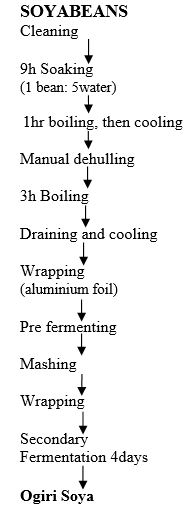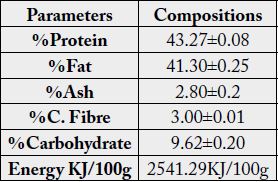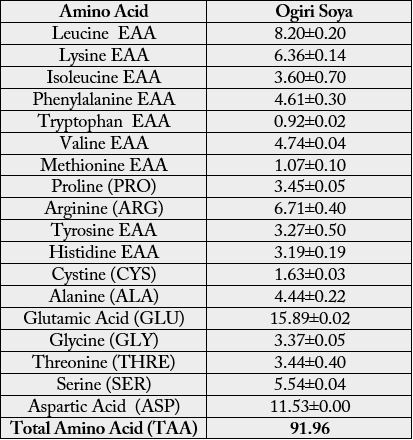Biography
Interests
Nzelu, I. C.* & Ubaka, K. K.
Department of Food Technology, Federal Polytechnic, Oko, Anambra State, Nigeria
*Correspondence to: Dr. Nzelu, I. C., Department of Food Technology, Federal Polytechnic, Oko, Anambra State, Nigeria.
Copyright © 2019 Dr. Nzelu, I. C., et al. This is an open access article distributed under the Creative Commons Attribution License, which permits unrestricted use, distribution, and reproduction in any medium, provided the original work is properly cited.
Abstract
The proximate, amino acid and sensory quality of “Ogiri” soya produced from soya beans (Glycine max) were studied. The “Ogiri” soya had 43.27±0.08%, 41.30±0.25% and 9.62 ±0.20% for crude protein, crude fat and carbohydrate contents respectively. Its energy value amounted to 2541.29KJ/100g. Reasonable quantities of all the essential amino acids (EAAs) including histidine were obtained. In g/100g unit, lysine was 6.36±0.14, leucine was 8.20±0.20, Isoleucine was 3.60±0.70, valine was 4.74±0.04, phenyalanine was 4.61±0.30 while methionine was 1.07±0.10. Glutamic and aspartic acids had the highest concentrations of 15.89±0.02 and 11.53±0.00 respectively. There was no significant difference between “Ogiri” soya and “Ogiri egwusi” when used to flavoured bitter leaf soup. Soya beans could thus be used as the raw for “Ogiri” production.
Introduction
Soya bean which originated in eastern Asia is still widely cultivated in China, Japan, Korea, and other
countries but USA is the current largest producer of Soya beans. Soya bean is able to thrive in extreme
temperatures, from tropical Brazil, to the snows of Japan. In addition to its potential as a prime cash crop,
it has attractive features nutritionally due to its high content of protein, fat, which has poly unsaturation,
minerals and low starch content, Beddows (1988) and Chukeratirote (2015) [1,2].
In its natural form, soyabeans have little direct use as a food due to its poor digestibility as well as its beany taste and flavour, [3]. However, the soya bean seeds are unique because they can be converted to highly flavoursome products that could be used to enliven other diets especially through fermentation. Soya bean is the substrate from which fermented products such as Tempe, Thua-nao, Japanese Natto, Kinema (traditionally consumed in Nepal and Sikkin of India), Soy sauce and Javanese oncom; are made [3,4]. Kinema is still being produced by a traditional art in individual households, [5]. In the process, soya bean seeds were washed, soaked overnight, cooked by boiling for 90mins, crushed into grits, wrapped in fern or banana leaves and covered with sack cloth and allowed to ferment for 1-3days in warm place 25-27˚C.After about 12hours, the surfaces of the fermenting soya beans grits were covered with a rough, white, viscous mass. Fresh kinema is fried in oil and then added to vegetables and spices to prepare curry. Soy dawadawa and “Ogiri” soya have also been reported by Popoola and Akueshi (1984/1985) [6], Akhuemonkhan and Badaru (2000) [7] and, Nzelu (2006). According to [3], Bacillus spp is the most dominant naturally fermenting agents in soybeans. The organism is hydrolytic and is associated with utilization and reduction of indigestible oligosaccharides and polysaccharides, and has been shown to reduce the activity of anti-nutrients which hinder availability of proteins and phytochemicals present in soybeans, [8]. The Proteolysis mainly contributes to product attributes including improved protein quality, digestibility, texture, appearance, as well as characteristic aroma and taste of fermented products.
“Ogiri” is a soup or sauce condiment produced traditionally in Nigeria by microbial fermentation of such oil seeds (also leguminous seeds) as Ricinus communis (Castor oil seed), Colocynthis vulgaris, Citrullus vulgaris and other varieties of melon seed, and, fluted pumpkin seed (Telferia occidentalis) among other seeds. Soya beans (Glycine max) is usually 100% to 200% cheaper, per measure than any of the known raw materials or substrates used for traditional production of the “Ogiri” product. The traditional method of “Ogiri” production which started ages ago has continued to rely on adventitious microorganisms for the fermentation of the substrates with the result that product quality remains inconsistent. According to Alais and Linden (1999) flavour-enhancing substances confer, as a rule a new aroma, while the development of strong odours seems to be the rule in foods, where Bacillus subtilis dominates [9].
Most condiments used as flavouring agents contain vegetable proteins rich in glutamine and asparagine. These can be hydrolysed enzymatically or chemically to Glutamic acid and Aspartic acid. Glutamic acid is recognized as a flavour agent [10]. At the same time, Glutamic and Aspartic acid contribute to the Umami taste [11] of which “Ogiri” products are. Soya bean was used for the production of “Ogiri” soya in this study, with a view to ascertaining the nutrients, amino acids and sensory quality of “Ogiri” soya product. This will encourage the extension of use of soya beans as a substrate for traditional Production of “Ogiri”.
Materials and Methods
The golden coloured soya bean used in this work was purchased from Eke Ekwulobia market, Ekwulobia in
Aguata Local Government Area of Anambra State, Nigeria.
Soya bean seeds were cleaned by winnowing, sorting, and manual removal of pieces of string, stones and
other extraneous materials as shown in Figure 1. The cleaned golden coloured seeds were soaked for 9h in
1:5 (beans: water) potable water. The soaked beans were then removed into a stainless steel pot to which
potable water had been added and the beans were boiled for 60mins. The boiled beans were then removed
from the pot and cooled to about 30ºC, a manageable temperature for the dehulling for removal of the
beans’ hulls. The dehulled beans were wrapped with aluminum foil paper and boiled for 3h after which the
wraps were pierced using tooth picks and, incubated by the fire side for the next 4 days. The wraps were
turned from one side to the other thrice daily. On the fourth day, stainless steel hand grinder (Corona brand)
was sterilized in boiling water and used to grind the fermented beans while the used aluminum foil paper
was discarded. The ground soya beans’ mash was wrapped with fresh aluminum foil paper for secondary
fermentation. The proximate and amino acid profiles of the “Ogiri” Soya were analyzed on the fourth day of
secondary fermentation.

The Proximate composition of the Ogiri soya sample was determined using the standard methods of AOAC
(2010). Analar grade of chemicals were used. The energy values were calculated using the factors: 4.1 (for
carbohydrates and protein); 9.4 for the fat (Fox and Cameron 1989) and the results were recorded on Table
1.

Values are means ± Standard deviation of triplicate determinations.
The Amino Acid profile was determined by Benitez (1989) [14] method. The Technicon Sequential Multiple
(TSM) Amino Acid Analyzer (Technicon Instrument Corporation, New York) was used to determine
the different amino acid composition of the “Ogiri” soya sample. The amino acid values reported were the
averages of three determinations.
About 2.0g of “Ogiri” soya sample was weighed into the extraction thimble and the fat was extracted with
chloroform/methanol (2:1 v/v) mixture, using soxhlet apparatus (AOAC 2005) . The extraction lasted for
between 5-6 hrs. About 30mg of the defatted “Ogiri” sample was weighed into a glass ampoule. Seven millitres
of 6M HCL was added to the ampoule and oxygen expelled by passing nitrogen gas into the sample.
The glass ampoule was sealed with Bunsen flames and placed into an oven at 105ºC for 22hrs. The ampoule
were allowed to cool, then filtered to remove the humins. The filtrate was then evaporated to dryness at 40ºC,
using a rotary drier under vacuum. The residue was dissolved with 5ml acetate buffer (pH 2.0) and stored
in a plastic specimen bottle, and lastly analysed for their amino acid contents. Tryptophan was determined
by Maria et al (2004) [15] method. The “Ogiri” sample was hydrolysed with 4.2M sodium hydroxide. The
known sample was dried to constant weight, defatted, hydrolyzed, evaporated in a rotary drier evaporator
and loaded into the Applied Biosystems Phenylthiohydration (PTH) Amino acid Analyser.
The “Ogiri” soya product was used to flavour bitterleaf soup. In the process, the normal soup ingredients were
prepared and cooked with sequential additions of all the ingredients excepting the “Ogiri”. Then the soup
was divided into two equal portions. The two portions were each flavoured respectively with equal quantities
of “Ogiri” soya and “Ogiri egwusi”. Each portion was simmered for 10minutes at low heat. The soup samples
were then evaluated for the attributes of aroma, taste and overall acceptability using the Hedonic Scale [16].
Seven (7) panel members who were parents and already familiar with Ogiri-flavoured soups were used. The
judges were asked to show their preference by scoring the soups for flavour, aroma and overall acceptability
on a 9-point hedonic scale where 9 represented “like extremely”, 5 represented neither like or disliked and 1
represented disliked extremely. The panelists rating wereanalyzed using T-test, [17-19]
Data from proximate and amino assays were collected in triplicate determinations and means ± standard deviations
(SD) were computed. Data obtained were analyzed by oneway analysis of variance (ANOVA) using
the SPSS version 17 (2014) statistical procedure and significance was accepted at 0.05 level of probability.
Result and Discussion
The results of the proximate composition, amino acid composition and sensory quality of the “Ogiri” soya
were recorded in Tables 1 and 2.

Values are means ± Standard deviation of triplicate determinations
The protein, fat and carbohydrate content of the “Ogiri” soya were 43.27±0.08%, 41.30±0.25%, and 9.62±0.20% carbohydrate respectively. These results compared favourably with results obtained by other researchers for “Ogiri” products. Nzelu and Onyekwelu (2017) [19] reported 35.08%, 46.30% and 4.02% respectively for protein, fat and carbohydrate from castor oil seed “Ogiri”, while David and Aderinbigbe (2010) [20] reported a range of 24.60% to 32.00%; 20.24% and 43.20%; 23.60% and 25.20% for protein, fat and carbohydrates respectively for fermented melon seeds’ product. Shrestha et al (2010) [3] reported 35.70% to 40.30% of crude protein in kinema product. It is believed that increase in protein content is associated with the increase in microbial synthesis of protein or enzymes or, re-arrangement of compounds followed by degradation of other compounds, [21]. Proteolytic activity is a key step in the fermenting process. During fermentation, soy proteins are hydrolyzed to peptides, amino acids and ammonia [2]. Oboh (2006) [22] reported 44.6%, 21.0% and 3.0% protein, fat and ash respectively from fermented soya beans. While Dajanta, Chukeatirote and Apichartsrangkoon (2012) [23] reported of 38.94% to 42.06% protein, 20.37% to 52.22% fat and 4.7% to 5.44% ash from thua nao fresh product, made from Bacillus spp. The ash and crude fibre of the “Ogiri” soya in this study were 2.80±0.2% and 3.00±0.01% respectively. Oboh (2006) obtained 3.0% ash and 5.9% crude fibre from fermented unnamed product of soya beans and also 1.9% ash and 7.8% fibre from melon seeds. The minerals’ content of the “Ogiri” soya product will be dependent on the ash.
Table 2 shows the mean quantities of the component amino acids that made up the protein of the “Ogiri” Soya.
There were significant differences (P<0.05) among the amino acids. Eighteen (18) amino acids were detected using the Benitez (1989) [14] method. Both the non-essential amino acids (NEAA) and the essential amino acids (EAA) were detected. The EAAs were: Isoleucine, Leucine, Lysine, Methionine, Tryptophan, Tyrosine, Valine, Phenylalanine, including Histidine, all designated EAA, were determined. Glutamic Acid (GLU) and Aspartic Acid (ASP) had the highest concentration quantitatively among the amino acids. Glutamic Acid and Aspartic Acid contribute to Umami tastes, (Jeleń, 2012) [11]. All the amino acid quantities from “Ogiri” soya (OS) were higher than the equivalent quantities from “Ogiri” “ugu”, (OU) produced from fermented fluted pumpkin seeds as reported by Dimejesi and Odibo (2017) [24]. For example, the essential amino acids obtained from the two condiments (in g/100g) for OS: OU ratio were 6.36:3.10 for lysine; 8.20:5.48 for Leucine; 3.60:3.10 for Isoleucine; 1.07:1.23 for Methionine; 3.27:2.53 for Tyrosine; 0.92:0.50 for Tryptophan; 4.74:4.60for Valine; 4.61:3.78 for Phenylalanine; and 3.19:2.20 for Histidine. However, Methionine and Cystine (Sulphur containing amino acids), remained some of the limiting amino acids because the substrates for “Ogiri” production were from legume plant sources. The values of the Essential amino acids (EAAs) also compared favourably with the FAO’s (1985) estimated EAA’s requirement for adults.
The results of sensory evaluation carried out on the “Ogiri” products are given Table 3. From Table 3, “Ogiri
egwusi” had higher means for the aroma, flavour and overall acceptability parameters than the corresponding
parameters for “Ogiri” soya. The mean scores obtained from the panelists using the preference test through
the Hedonic scale were then compared using the t-test table. When tcal is < ttab then there is no significant
difference (p>0.05) between the products or parameters being compared. The data showed that for aroma,
flavour and overall acceptability there was no significant difference between the two “Ogiri” products. Thus
“Ogiri” soya was as effective as “Ogiri egwusi” when used to flavour bitter leaf (a traditional) soup [25,26].

Values followed by the same superscript in the same column are not significantly different at (P>0.05)
Conclusion
The results from the study have shown that “Ogiri soya” has high contents of crude protein, fats and energy
values. Fermentation of soyabeans has led to improvement of nutritional and sensory qualities of soyabeans.
Fermentation thus helped remove the beany odour of raw soyabeans and increased the sensory quality of
the product. At the same time the amino acid profile is good. Besides, the values of the essential amino acids
(EAAs) obtained compared favourably with the FAO’s (1985) [27] estimated amino acids requirement for
adults. Users of traditional “Ogiri” condiments were very much at home with the “Ogiri” soya flavours as
there was no significant differences between “Ogiri” soya and another “Ogiri” product used as control. Soya
bean seeds have versatile products. The use of soya beans as raw material for “Ogiri” soya production is highly
recommended.
Bibliography

Hi!
We're here to answer your questions!
Send us a message via Whatsapp, and we'll reply the moment we're available!